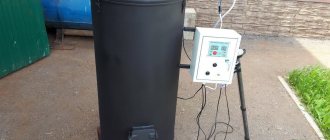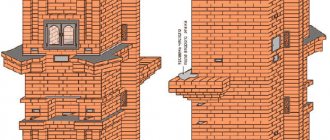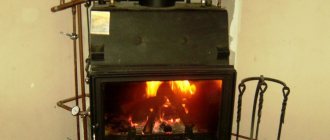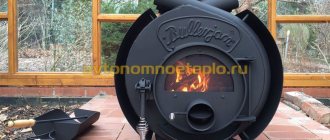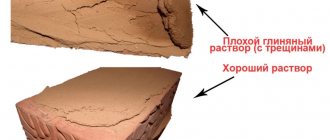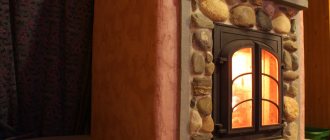We use pyrolysis stoves to heat a house or bathhouse
One of the options for economical fuel consumption is the use of long-burning stoves or boilers. Using the same amount of fuel, they work much longer than other types of heating devices. Long-term combustion furnaces also include new pyrolysis furnaces.
The operation of these furnaces is based on the principle of the pyrolysis process - the thermal decomposition of any organic substances into pyrolysis combustible gases and solid residues. After this process, at high temperature, the resulting pyrolysis gas is mixed with oxygen. According to the laws of chemical reactions, this promotes almost complete combustion of both the gas itself and the fuel.
If at some stage you separate the solid residues from the composition, then, strangely enough, you get coke, and the equipment can be called a charcoal kiln. During heating, the main heating of the air is obtained due to the release of heat during the combustion of pyolysis gas mixed with air.
Advantages of pyrolysis ovens:
- High efficiency of the furnace. The fuel here burns more thoroughly, and much more heat is extracted from it.
- Environmental Safety. This is achieved due to the fact that very small amounts of harmful substances are present in the gases leaving the chimney.
- Fairly quick warm-up.
- High efficiency (up to 85%), which compares favorably with conventional boilers.
- Large power interval (thermal). This oven can operate at 5 and 100 percent of its capacity.
- Possibility of connecting any heating circuit to the device.
- Makes it possible to use various types of fuel (including raw firewood, tires and garbage.
- Requires minimal human participation in its work
The disadvantages include the rather large size, the presence of a site for fuel reserves, the presence of foreign odors when burning waste, the need for ventilation of the room, and the accumulation of condensate in the outlet channel and chimney.
Charcoal kiln "Continuous"
Technical and economic indicators
| No. | Indicator name | Meaning |
| 1. | Productivity of finished products, t/hour | 0,435 / 0,7 / 1,4 |
| 2. | Wood consumption per 1 ton of charcoal, m3 | 6,3 |
| 3. | Process water consumption per 1 ton of finished product, thousand m3 | 0,06 |
Brief description of the technology
To obtain gastronomic charcoal, it is necessary to comply with technological standards during its production (EN 1860, DIN 51749-H, AFNOR). The produced coal will have the following chemical composition:
- Solid carbon content Cfix 78 – 88%
- Volatile matter content 12 – 16%
- Moisture content < 6%
- Ash content < 4%
Coal fractions that reach sizes of 20-60 mm and above meet the standards and are considered commercial.
Logs, the size of which is no more than 30 cm, are placed in hopper 9. Then a special lifting device loads the material into a paired dryer 21 and 22 (vertical direct-flow). Loaded logs are fed through a distribution hopper and sealed chambers (loading).
The drying process is achieved by supplying coolant and wood to the top (direct-flow operating principle). The maximum temperature is set, which corresponds to 2300. This temperature is achieved by adding recirculating gas. Regular air supply is also possible.
After drying, the wood falls down into the retort chamber, equipped with a special double shutter that closes hermetically. The wood then passes into retort 1 (vertical with continuous action).
While the wood falls down, a coolant is supplied moving upward, thanks to which the processes necessary for the production of the final product (pyrolysis) - coal - occur.
Production flow diagram
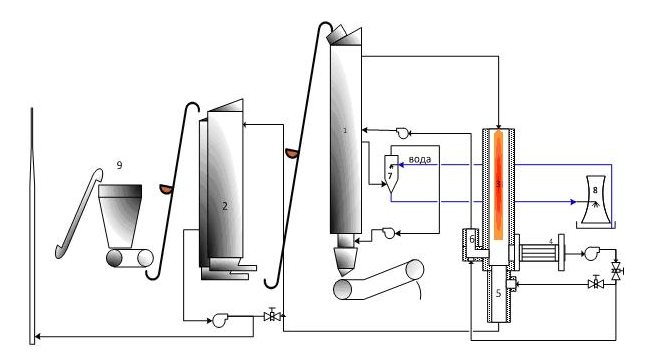
The gas blower increases the temperature to 500-600 degrees and supplies coolant to the middle of the retort (the supply temperature directly affects the type of coal produced). After passing through the retort, the coolant, together with the pyrolysis products, is discharged in the upper part of the retort at a temperature of 1500C. The produced charcoal, continuously descending, passes through the coolant input zone, after which it enters the cooling zone, which is located at the bottom of the retort. Cooling occurs by supplying cold flue gases with a temperature of 30-40 degrees to the lower part of the retort. Cooling gas is removed from the middle part of the retort at a temperature of 350 degrees.
After cooling, the resulting coal, passing through an unloading chamber with a double sealed shutter, using an automatic device (conveyor), enters intermediate bunkers.
Only quality charcoal enters the bunker. The fine fraction is pre-screened; it, in turn, can also be used in industry.
The coolant, which has already been used, and pyrolysis products (resin, various acids, flammable gases) are discharged into the steam-gas furnace 3 through the upper part of the retort. Air is blown here using a fan. The supplied air is regulated based on the oxygen content in the combustion products thanks to a valve. The firebox has been increased in volume to 50 m3 for complete and residue-free disposal of flammable products. The temperature in the firebox can reach 1300˚C. During the process in the firebox, combustion products are divided into three parts. Utilization of the first takes place in boiler 4, in which steam is formed, as well as primary cooling of combustion products to 200-2500... The second part is sent to mixing chamber 6 to prepare the coolant and then feed it into the retort. The third flow goes to mixing chamber 5, where the coolant for drying raw materials is prepared.
The exhaust gases are removed from the waste heat boiler using a fan and are also divided into 2 streams. The first is sent to the mixing chamber of the dryer, the second - to the mixing chamber of the retort. This is necessary to ensure the required coolant temperature in both places. The separation of gases into flows and their regulation occurs thanks to dampers.
The coolant and cooling gas in the retort are in a closed ring. The waste coolant is discharged from the dryer through a special chimney.
The firebox is equipped with a special gas burner inside to ensure that the retort starts up within 24 hours (start-up period). In the absence of gas, the furnace can operate on liquid fuel.
What is pyrolysis gas
Wood pyrolysis is a change in the structural composition of wood matter when exposed to temperature. This process is isothermal, that is, it releases heat.
As a result of pyrolysis, wood decomposes into:
- Volatile carbons;
- Charcoal.
The products of wood pyrolysis are, in turn, flammable substances. It is these substances that, when burned, release heat as the final goal of the heat treatment process itself.
Long-burning pyrolysis furnaces
Among all metal boilers and stoves, the most popular today are heating devices that have a long-term combustion function. These devices are very economical and especially easy to use. They are suitable for both small country houses and permanent residences.
There are many different models of pyrolysis boilers and furnaces on the market today, including one, but it is quite possible to make such a device yourself.
The features of this heating device include:
- Large firebox volume and larger fuel door. This allows you to stack a lot of firewood or other materials at once.
- Dividing the firebox into two compartments. One of them is intended for smoldering wood, in the other the process of burning gases occurs.
The presence of a fire stop from the chimney. In common parlance it is called a tooth and looks like a plate that is welded to the top of the firebox. It prevents flame from entering the pipe.
In a simple boiler, the heating function consists of increasing the temperature of the stove itself and the room, as well as the subsequent release of heat from the already heated surface. The fuel here burns quite intensively. If the stove is metal, this turns out to be very inconvenient. The fuel does not burn at all. It needs to be constantly added, and the temperature in the house rises and falls. In a long-burning stove, the process occurs differently. A simple stove is lit from below, and only then the fire in it goes up and to the sides. The flame is large and the wood burns out very quickly, leaving a lot of coals. This happens because there is constantly open air access into the oven. Long-burning devices work differently - the wood is ignited from above, and then the flame spreads downwards. And only to the place (burner) where the wood is burning does air spread. The combustion process is not too intense, more like smoldering. At the same time, much less heat is generated. The heat in the room remains at the same level. In addition to the firewood itself, the pyrolysis gas generated during the smoldering of firewood is also burned in the stove. It moves to the second chamber, where it intensively mixes with air. As a result, the secondary combustion products do not contain harmful substances, and the efficiency of the stove increases significantly, helping to reduce heating costs.
Principle of operation
So, let's take a closer look at how a long-burning stove works. In fact, it has already been described above in what sequence heat transfer occurs. But we are now interested in the process occurring in the first combustion chamber. So experts call it differently: pyrolysis, hydrolysis, gas generation. In simple terms, it will be “smoldering,” which, in principle, is what happens, because solid fuel simply cannot burn at a low oxygen concentration. The only thing left is to smolder.
Let's look at how the process of heating a cold house occurs. Solid fuel is placed in the long-burning stove and ignited. In this case, the blower valve opens completely. It is important here that the fuel ignites immediately and begins to produce the maximum value of thermal energy. The house is cold, and our task is to quickly heat it to the required temperature. By the way, with this stove you can heat a small house in half an hour.
So, the house has warmed up, you can move on to the low-calorie process. That is, the blower damper practically closes, thereby blocking access to the combustion chamber of fresh air, which is what we need. The best option is if the stove is filled with a new batch of fuel, then you can expect that its burning time will be as long as possible.
I would like to add that manufacturers today offer a fairly wide range of long-burning stoves. And each consumer can choose a model based on power, frequency of fuel supply, and external data.
Homemade smokeless stove with your own hands
Capable and talented specialists can make a pyrolysis stove with their own hands. However, in practice, this requires great knowledge, skill and experience. In addition, daredevils who dare to make such an invention should know that in practice there are several pitfalls, over which many home-made devices have already crashed.
To perform the work you need the following equipment:
- Welding machine;
- Well-designed drawing;
- Experience working directly in the furnace business.
However, even the presence of all this will not provide a complete guarantee of success in fulfilling your plans. The work also requires good, high-quality materials, and their cost is now quite high. This mainly concerns the metal part, where good alloy steel must be used. In addition to everything, this unit also has an electronic system, without which the process of controlling the device is impossible. And without it, the operation of the device will not make sense. Therefore, before deciding to make a pyrolysis furnace yourself, you should carefully consider all the nuances. It is possible to build a working model of such a stove, but its efficiency will be significantly lower than that of a high-quality industrial model, and your device will not pay for itself in fuel costs. In addition, if you cannot correctly configure the electronic part of the boiler, then you will have to constantly be near the boiler and monitor it. Many of the poorly designed pyrolysis stoves have turned into another type of potbelly stove.
Advantages and disadvantages
Like any heating device, these long-burning units have both their pros and cons. Therefore, when choosing one model or another, each of us must come to terms with the shortcomings that will be present in the heating device you choose.
Advantages
- Huge fuel savings. This is the greatest advantage of long-burning stoves. And no matter what adherents of other models say, you cannot argue with this factor. The savings are obvious and so great that the choice leaves no alternatives.
- Efficiency. This has already been discussed above, we just note it as a given.
- Selection of dimensions. Currently, manufacturers offer small models and presentable appearance of stoves that will fit into any interior of a home or cottage. In any case, they won’t be ashamed.
- Easy to maintain. Long-burning stoves make it possible to add fuel at regular intervals. By the way, this indicator varies in a fairly wide range from 5 hours to 2 days.
- Ability to use a wide range of combustible materials as fuel. There are not only solid fuels, but also liquid ones. By the way, long-burning combined boilers have already appeared on the market today.
Can you say which is better: a hydrolysis boiler or a pyrolysis furnace?
Hydrolysis heating boilers, as you know, are devices that run on solid fuel. For their work, they use firewood, straw, wood waste, coal, pellets and much more. These boilers, burning wood and coal, have become widespread in heating systems for industrial and domestic premises. The advantages of such boilers include efficiency, ease of use, high environmental friendliness, and accessibility. Hydrolysis boilers can be used even where there are interruptions in the power supply or there is no electricity at all.
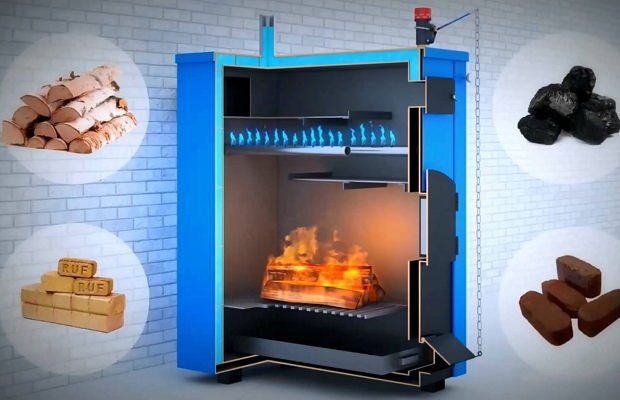
A long search for new energy-saving technologies has found it possible to qualitatively use the knowledge of organic chemistry.
Scientists have noticed that:
- In a high-temperature environment, in conditions of limited access to oxygen, the combustion process of some solid natural substances is accompanied by the constant release of flammable gas;
- The resulting gas is suitable for further combustion;
- During its combustion, a lot of heat is generated.
In other words, the hydrolysis boiler can be called the progenitor of the new pyrolysis boiler. But it is indispensable where installation or maintenance of a modern model is impossible.
Advantages and disadvantages
Wood burning process
The pyrolysis plant has a number of advantages, among which the following should be highlighted:
- Due to the complete combustion of wood and the duration of operation on one load, such stoves are highly economical.
- It heats up quite quickly, providing effective heating of the room.
- High efficiency of about 85% (higher than conventional furnaces).
- Environmental Safety. The combustion products of such furnaces contain a small amount of dirty and harmful substances, which is why such installations are called smokeless.
- Ability to work in a wide range of thermal power (5-100%).
- Any heating circuit can be connected to installations of this type.
- Pyrolysis ovens require minimal supervision during operation. Fuel is loaded approximately once a day, and ash is unloaded approximately once a week without stopping the operation of the unit.
- You can load different fuels into the stove. It can be either solid or liquid. This includes damp firewood and various garbage (even car tires). Special designs have also been developed for burning waste machine oil.
There are disadvantages to such long-burning designs, but they are significantly fewer than the advantages:
- They are very large in size.
Scheme of a wood-burning pyrolysis boiler
- A special platform is needed to place the fuel.
- Since some impurities and odors are released during operation of the stove, the room where it will be installed needs ventilation.
- Since the escaping gases have a low temperature, this leads to the accumulation of condensation. It is present in the chimney and outlet duct. To collect it, a built-in storage device is often provided.
Advice! Due to the formation of condensation, it is necessary to provide a larger diameter of both the chimney itself and the outlet pipe, which must be insulated from the street. This will prevent it from freezing due to lower ambient temperatures.
- To ensure truly high-quality operation of the heating system, it is necessary to install a fan in the furnace, and provide a pump for the heating system itself. All this leads to the dependence of the structure on the electrical network.
